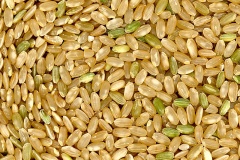Rice (incl. transport guidelines)
| Infobox on Rice (incl. transport guidelines) | |
|---|---|
| Example of Rice (incl. transport guidelines) |  |
| Facts | |
| Origin | This table shows only a selection of the most important countries of origin and should not be thought of as exhaustive.
|
| Stowage factor (in m3/t) |
|
| Angle of repose | - |
| Humidity / moisture |
|
| Oil content | - |
| Ventilation | Loading as bulk cargo: surface ventilation. Loading as general cargo: air exchange rate 15 - 25 changes/hour. Good surface ventilation and airing are necessary. |
| Risk factors | At an excessively high water content in particular, rice has a tendency towards self-heating. Water contents of > 15% and relative humidities of > 75% result in self-heating of the cargo due to hydrolytic/enzymatic fat cleavage. Rice is highly odor-sensitive, prone to contamination and shrinkage. Beware of infestation. |
Rice (incl. transport guidelines)
Contents
Transport guidance on bagged rice
As a cereal grain, rice is the most important staple food for a large part of the world's human population, especially in Asia and the West Indies. It is the grain with the second-highest worldwide production, after maize (corn).
Since a large portion of maize crops are grown for purposes other than human consumption, rice is the most important grain with regard to human nutrition and caloric intake, providing more than one fifth of the calories consumed worldwide by the human species.
Therefore we have extended the article on rice to a transport guidance, in order to prevent loss as much as possible.
Introduction
1.1 Types of rice cargoes
vvvvv











